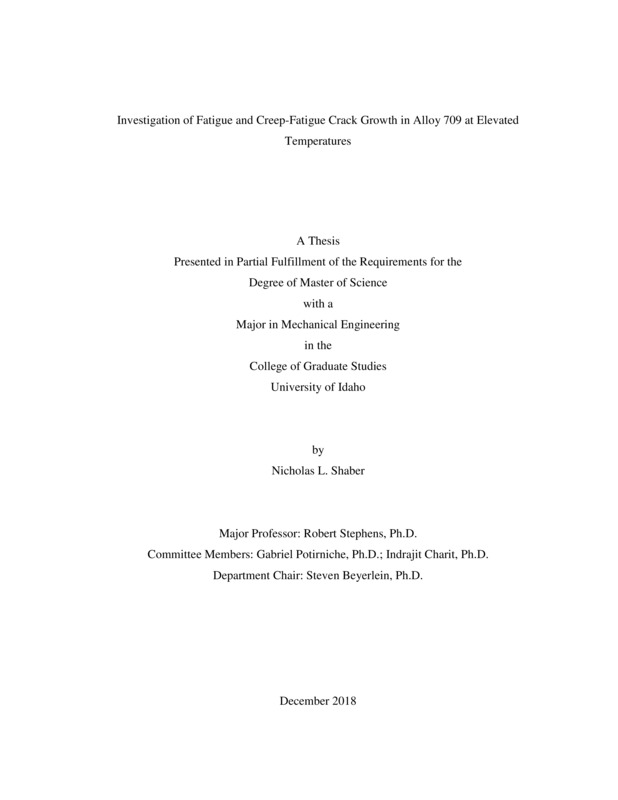Investigation of Fatigue and Creep-Fatigue Crack Growth in Alloy 709 at Elevated Temperatures
Shaber, Nicholas. (2018-12). Investigation of Fatigue and Creep-Fatigue Crack Growth in Alloy 709 at Elevated Temperatures. Theses and Dissertations Collection, University of Idaho Library Digital Collections. https://www.lib.uidaho.edu/digital/etd/items/shaber_idaho_0089n_11499.html
- Title:
- Investigation of Fatigue and Creep-Fatigue Crack Growth in Alloy 709 at Elevated Temperatures
- Author:
- Shaber, Nicholas
- Date:
- 2018-12
- Keywords:
- Alloy 709 Austenitic Crack Growth Creep Fatigue
- Program:
- Mechanical Engineering
- Subject Category:
- Mechanical engineering
- Abstract:
-
The service life of Generation IV nuclear reactors is seeking to increase to 60+ years. With increased service life, the likelihood of creep-fatigue failures of structural components increases. Understanding creep-fatigue crack growth behavior is essential for structural applications within nuclear reactors and the power generation industry. Most service conditions involve a combination of creep and fatigue loading. Testing materials in the laboratory is critical to understanding the mechanics of creep-fatigue damage. To date, considerable work in the area of creep-fatigue characterization has taken place on various stainless steel power plant materials. A recently developed austenitic stainless steel Fe-25Ni-20Cr (Alloy 709), in consideration for various high temperature reactor applications, has yet to be properly and sufficiently characterized. Characterization of the creep-fatigue and fatigue properties of Alloy 709 in this study utilized the standard compact tension specimen geometry. The temperature conditions investigated included 550, 600 and 700℃. Proper exemplification of material characterization and consistency of processing techniques was the primary focus of this research. Testing included three separate batches of material that were provided by the project sponsor. To investigate the effect of prolonged exposure to elevated temperatures, the third batch of material consisted of three aging schedules: as-received, aged 1 and aged 2. Testing conditions under fatigue loading included loading ratios, R, of 0.1, 0.3, 0.5 and 0.7. R-ratio effects on crack growth rate were characterized in terms of da/dN versus ΔK. For investigation of creep-fatigue crack growth, hold times of 60 and 600s were tested. Fracture surface and crack plane characteristics were investigated with the aid of scanning electron microscopy, electron backscatter diffraction and optical imaging. The primary conclusion from this study indicates minimal sensitivity to loading conditions. Under creep-fatigue loading, creep crack growth was minimal at lower hold times. At a hold time of 600s, there was a noticeable increase in crack growth rate. Fracture surface and crack profile imaging indicated transgranular primary and secondary crack propagation. Crack topography and secondary cracking noticeably increased as hold time increased. Material in both aged 1 and aged 2 conditions showed little influence on crack growth rates under any tested loading condition of fatigue crack growth or creep-fatigue crack growth.
- Description:
- masters, M.Engr., Mechanical Engineering -- University of Idaho - College of Graduate Studies, 2018-12
- Major Professor:
- Stephens, Robert
- Committee:
- Potirniche, Gabriel; Charit, Indrajit
- Defense Date:
- 2018-12
- Identifier:
- Shaber_idaho_0089N_11499
- Type:
- Text
- Format Original:
- Format:
- application/pdf
- Rights:
- In Copyright - Educational Use Permitted. For more information, please contact University of Idaho Library Special Collections and Archives Department at libspec@uidaho.edu.
- Standardized Rights:
- http://rightsstatements.org/vocab/InC-EDU/1.0/

